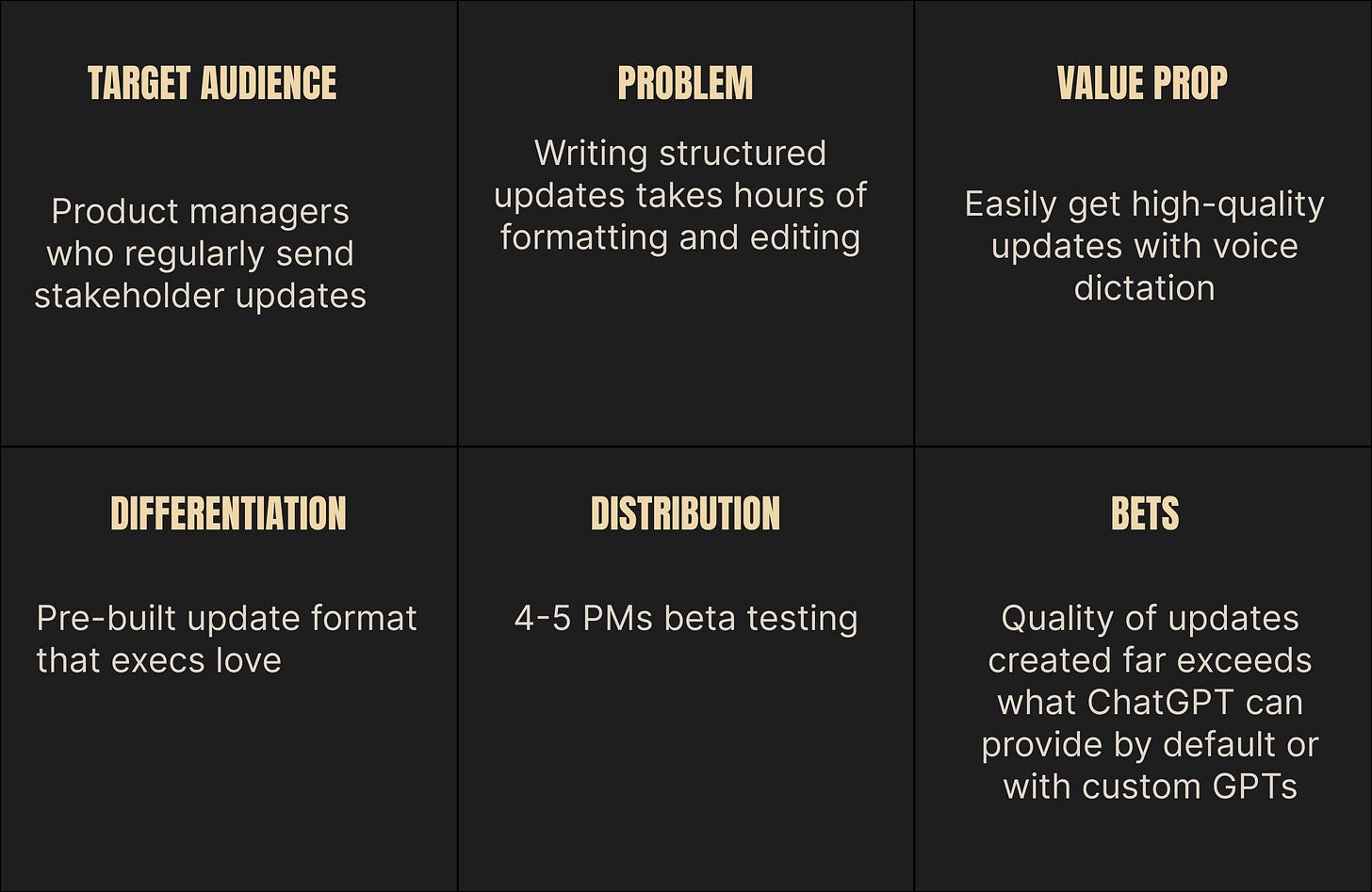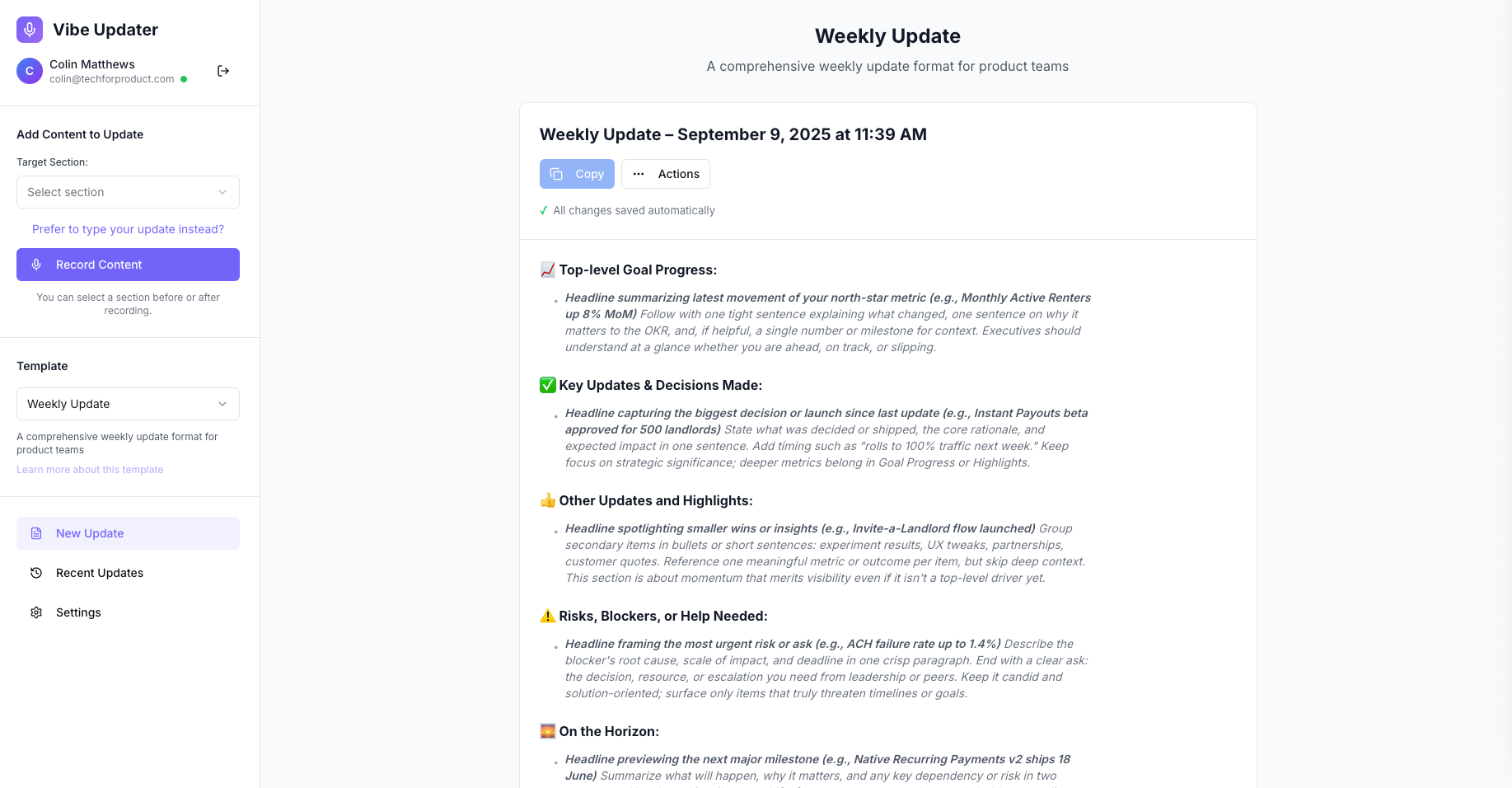How a PM at Zillow Turns Voice into Stakeholder Updates
Building personal apps as a non-technical PM
Hey, I’m Colin! I help PMs and business leaders improve their technical skills through real-world case studies. Subscribe to paid to get access to the AI Product Circle community on Slack, my full Tech Foundations for PMs course (84 lessons), a prompt library for common PM task, and discounts for live cohort-based courses.
Pat Bergstresser, a product manager at Zillow, approached me with an interesting challenge. Despite having no coding background beyond SQL queries, he'd taken my AI Prototyping course and was now building his second AI-powered product using Replit.
His creation, Vibe Updater, solves a problem every PM knows well: bi-weekly update emails that used to take him 2-3 hours now take just 15 minutes. Let’s dive in to what he built, how it went, and he’d do differently.
The Plan
Pat's approach was straightforward. He wanted to build a voice-to-text tool that also PMs to narrate freeform content and transform them into executive-ready updates.
Target persona: Product managers who regularly send stakeholder updates
Core problem: Writing structured updates takes hours of formatting and editing
Value Prop: A tool that records voice input and automatically formats it into a professional, structured update following a proven template
Differentiation: Pre-built update format that execs love, so you can just narrate and not worry about editing.
Distribution: Currently in early access with just 4-5 PMs testing
The Build
Despite not being a professional engineer, Pat built the entire product solo using Replit:
The technical architecture is simple but effective:
Voice recording using OpenAI's Whisper API for transcription
Database integrated directly in Replit (avoiding the complexity of external databases like Supabase)
System prompts that format content into Pat's proven update structure
Export options for rich text files, email, or direct copy/paste
Each section follows a specific structure: bold headlines that capture the main point in 30 seconds or less, followed by details for those who want to read more.
How It Went
The product is still in early stages, but the feedback from Pat’s leadership has been remarkably positive. The development process revealed some interesting challenges:
Planning is everything: Pat spends most of his time planning features before implementation. He uses ChatGPT for brainstorming and structuring, then creates detailed prompts for Replit with specific increments.
Incremental development: Rather than asking Replit to build everything at once, Pat breaks features into small increments, testing each one before moving forward. For example, he shipped a feedback feature by:
First creating the database schema and API endpoints
Then adding the UI with a feedback button
Testing thoroughly before adding voice recording capability
Debugging requires patience: When bugs appear, Pat screenshots them and asks Replit to explain before fixing. He's learned to tell Replit to "look at relevant files" to ensure it has proper context before making changes.
What Pat Would Do Differently
Pat's first attempt was a personalized greeting card creator called Card AI. The project became too complex - requiring graphical UI for card designs, integration with printing services, and handling physical mail delivery. He pivoted to Vibe Updater, which better matched his technical capabilities and Replit's strengths.
His key learnings:
Voice input changes everything - "When I type, sometimes I limit what I'm gonna say just because I'm trying to get it out quickly. But with voice, I don't overthink it."
Replit needs explicit instructions - "You have to be very clear and specific. It really helps you empathize with engineers when you just give them open-ended requests."
Manual testing is critical - "You have to test test test and not even just test what you just did but make sure what you just did didn't break something else."
Pat's still considering whether to migrate to Cursor for more robust features, but for now, Replit's integrated database and simpler workflow are meeting his needs. He's already working on the next feature: a "quick update" format for when managers need immediate status reports.
The most striking aspect of Pat's journey is how he's maintained his non-technical identity while building real products. He doesn't fully understand hooks or all the technical details, but he's learned enough about client-server architecture and database concepts to debug effectively and guide the AI tools toward working solutions.
For PMs interested in trying Vibe Updater, it's live at vibeupdater.com. And if you're a PM thinking about building with AI but worried about your technical skills, Pat's story shows what's possible with the right tools and mindset: "It's not like I'm looking at the code files and I can understand them all... but I'm able to actually make some progress."



